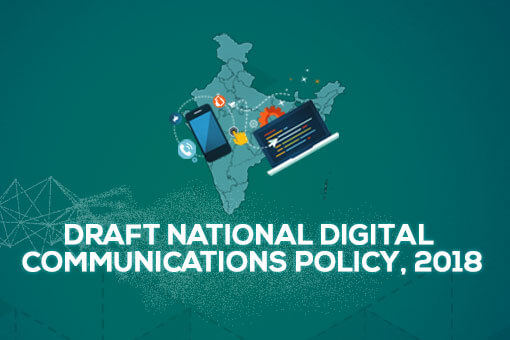National Digital Communications Policy, 2018

________________________________________________________________________________
This Blog is written by Srishti Tiwari from University School of Law and Legal Studies, GGSIU, Delhi. Edited by Priyanjali Priyadarshini.
________________________________________________________________________________
INTRODUCTION
As today’s technological world has entered the age of technological advances in the telecom sector such as 5G, Internet of Things (IoT), and connectivity from Machine to Machine (M2M), etc. There was therefore a need for ‘I for India’ to implement a customer-focused and application-driven strategy for the Indian Telecom Sector.
The primary objective of this policy was to serve as Digital India‘s main pillar by addressing emerging opportunities for expanding not only the availability of telecom services but also telecom-based services. New National Digital Communications Policy 2018 (NDCP) has been formulated accordingly.
On 26th September 2018, the Union Cabinet approved the National Digital Communications Policy, 2018. It seeks to promote India’s successful involvement in the new global economy. The main purpose is to achieve digital empowerment and enhanced well-being of the Indian people; and to this end, attempts to outline a collection of priorities, programs, objectives, and planned policy outcomes.
The NDCP also aims to ensure accessibility in all areas currently uncovered by channelizing the Universal Service Obligation Fund (USOF), thus improving citizen-centered accessibility as well as inclusiveness. Absolute inclusivity is a necessary first step to building a connected and shared digital network.
SIGNIFICANCE OF NDCP
• Provide free 50 Mbps internet access to all residents.
• Provide 1 Gbps of connectivity by 2020 to all Gram Panchayats, and 10 Gbps by 2022.
• Attract USD 100 billion of investments in the digital communications sector.
• Train one million New Age skill-building manpower.
• Establish a proper data protection regime for digital communications that safeguards individual privacy, autonomy, and choice.
• Expand IoT to 5 billion connected devices.
• Strengthen accountability through appropriate institutional mechanisms to ensure safe and secure digital communications infrastructure and services for citizens.
• Enables India to participate successfully in the global digital economy.
NEED FOR NDCP
With considerable capabilities in both telecommunications and software, India fully intends to benefit from utilizing new digital technologies and platforms to unlock productivity, as well as reaching our own and underserved markets, facilitating economic growth and development, generating new age jobs and livelihoods, and ensuring that its citizens have access to next-generation services. The growing and unprecedented proliferation of mobile phones, the internet, social media networks, and the explosive growth of digital payments, data consumption and generation across India indicate that more than a billion Indians have widespread exposure and empowerment opportunities in the data economy and emerging technology and services. It was widely estimated that a 10 percent rise in a country’s broadband penetration could theoretically lead to an increase in GDP of over 1 percent. Therefore, a consistent framework of policies and principles is needed to create a vibrant competitive telecom market to enhance India’s competitiveness in the long term. To expand mobile and broadband connectivity across the country, the opportunities presented by next-generation networks such as 5G and satellite communications need to be explored.
IMPACT OF THE POLICY
India must promote and safeguard fair competition across the communications and digital economy sectors. Provided the capital-intensive nature of the sector, the policy is aimed at attracting long-term, high quality, and sustainable investment by ensuring that regulatory structures and processes remain relevant, transparent, and accountable. The strategy intends to eliminate regulatory obstacles and reduce the regulatory burden impeding investment, innovation, and consumer interest. The Policy also outlines measures to improve the institutional structure and legislative process for the sector.
It promotes-
1) Establishing a National Digital Grid through the creation of a National Fiber Authority;
2) Establishing traditional service ducts and infrastructure corridors in all new projects in the city and on highways;
3) Creating a collective institutional framework between the Common Rights of the Way Centre, States, and local bodies, standardizing costs and timelines;
4) Facilitating the development of Next Generation Open Access Networks.
MISSIONS UNDER THE POLICY
The Policy sets some ambitious goals for the Indian digital communications and telecommunications (“telecommunications”) sector, ranging from providing 50 Mbps of connectivity, attracting $100 billion in investment into India’s telecommunications industry, and creating four billion jobs. These goals have been classified under three broad missions to be achieved by 2022. These are:
Connect India– through which the government seeks to build a robust digital communications structure by promoting broadband for everyone [1],
• Development of a ‘National Broadband Plan’ aimed at ensuring universal broadband access [2]
• Introduce broadband initiatives like BharatNet [3], GramNet [4], NagarNet [5], and JanWifi [6]
• Fiber First program [7] to introduce fiber to the home, business, and major growth institutions in Tier I, II, and III cities and rural clusters.
• Enhancing Satellite Communication Technologies in India by updating SATCOM policy, making new spectrum bands available, streamlining administrative assignment and allocation processes, clearances and permits associated with satellite communications systems, etc. [8].
• Helping to ensure customer satisfaction, service quality, and effective grievance redress by setting up a Telecom Ombudsman, framing a comprehensive policy to encourage the adoption of environmental and safety standards and encouraging the use of renewable energy technologies in the communications industry.
Propel India – through which the government seeks to allow technologies and services of the next generation through investment, innovation and Intellectual Property Rights (“IPR”).
• Implementing an action plan to phase out 5G software and facilities, and maintaining 5G spectrum coverage in 6 GHz bands. [9]
• Attract investments in the Digital Communications Market of USD 100 billion, extend the IoT.
• Creation of IPRs (Intellectual Property Rights) recognized internationally in India.
• Standard Essential Patents (SEPs) development in the field of digital communication technologies.
• Implementation of key recommendations regarding digital communications in the National IPR Policy.
• Simplifying the experimental licensing process and establishing regulatory sandboxes. [10]
• The development of a roadmap for the transition to Industry 4.0 by 2020 and the creation of a multi-stakeholder system contributed to the transition. [11]
Secure India– by which the government seeks to guarantee the sovereignty, protection, and security of digital communications to safeguard citizens’ interests.
• Ensuring that the core principles of data protection and security are applied and enforced [12].
• Telecom testing and certification of security to develop safety standards for equipment and devices, in line with global safety and security standards [13].
• Establishing a Central Register of Equipment Identity to address security, theft, and other concerns [14].
• Create pan-India public protection and disaster relief network [15] and develop a unified mechanism for responding to emergencies.
• Develop and deploy comprehensive security mechanisms for the digital communication network.
• Strengthen accountability through appropriate institutional mechanisms to ensure safe and secure digital communications infrastructure and services for citizens.
A stable, competitive marketplace ensuring the availability of new communications technology, services, and applications is essential for GDP growth, efficiency, and the development of new economic employment. The initiative to link India and provide all people with internet access would greatly improve the socio-economic progress of India. The policy aims at removing regulatory barriers and creating attractive investment opportunities in new segments of technology and stimulating the introduction of new technologies in India. The policy promotes the development of India’s telecommunications sector that has been in a persistent financial crisis. Implementing the policies outlined in the NDCP would encourage investment in various sectors including telecommunications, R&D, manufacturing, data centers. Accelerating the introduction of robots, IoT, and other related technologies, through data analytics, can lead to productivity improvements and improved decision making. Although the policy is a positive change, ultimate success depends on its execution. Pertinently, everyone is aware that India is grossly inadequate when it comes to fixed-line connectivity and this is becoming a major handicap when it comes to digital communications. This is intended to be addressed by including a new strategic initiative to “review the rationalization of license fees on fixed-line revenue to encourage digital communications.” Overall, a brilliant conclusion has thus been reached by an excellent policy that was made through extensive consultations over several months.
CHALLENGES
The Union Cabinet approved National Digital Communications Policy, 2018 has no new ideas on resolving the issues facing the telecom sector. Although restating the purpose of the Center to resolve the problems, it does not detail how it aims to accomplish the specified goals, nor does it include a clear timeline for implementing the various proposals. The total debt burden for the remaining players has burgeoned to alarming levels due to expensive spectrum auctions and massive cash flow reduction. Second, when it comes to the quality of service, telecom customers are no better today than they were two decades ago. Call drops, unwanted telemarketing calls, patchy data networks, and unfair practices are extremely prevalent in getting users to pay more. And to make matters worse, customers lack access to a fair and impartial arbitration process for grievances. Third, this sector’s public sector companies continue to languish under high labor costs. The new policy recognizes these problems, but in earlier regulations and vision statements almost all of the solutions offered are mentioned. Some of the main priorities specified in the 2012 policy have yet to be achieved. The truth is that the Department of Telecom has pursued these plans for many years only to be thwarted by the Ministry of Finance, which has so far seen the sector as a non-tax revenue source for the exchequer. If the Center wants to prepare the telecom sector of the country for the forthcoming digital revolution, it needs to go beyond giving mission statements to ensure that on-the-ground vision becomes true.
ANALYSIS
While it is promising to see the NDCP propose eliminating and easing regulatory obstacles that may impede investment, innovation, customer interest, and protection, it is, like previous NTPs, extremely short on information, timelines, and implementation measures. The NDCP 2018 also refuses to answer some of today’s telecom sector’s key financial sustainability issues, such as rising spectrum rates and the Department of Technology’s exceptionally high discretionary powers to enforce fines of up to INR 50 crores (approx. USD 7 million). The NDCP has also failed to recognize that some of the DoT’s older regulatory frameworks, such as the Audiotext / Call Conference Services regime for which the TRAI (Telecom Regulatory Authority of India) has already issued recommendations suggesting a revision of the current licensing regime, require a re-look. However, on the other hand, the NDCP aims to spur investments for the digital sector through various avenues such as ensuring a holistic and harmonized approach to harnessing emerging tech as well as stimulating research and development, startups, and local production. The year 2022 will be a milestone year if all the goals of the 2018 NDCP are achieved. The proposed Digital Policy is a genius policy move to officially concentrate not only on the telecommunications industry but also on the country’s digitization within its framework.
CONCLUSION
The policy paper incorporated provisions to encourage the adoption of “Optimal Spectrum Pricing” to ensure sustainable, reasonably priced access to digital communications. The new telecommunications policy recognizes the spectrum as a natural resource and as a corollary, ensures adequate availability, efficient use, and a fair and transparent method of allocation for service providers. The final policy provides looks to guide the evolution of the country’s telecom industry. Having considered the government’s drive towards a digitally empowered nation, the new policy has also focused on creating comprehensive data privacy and data protection roadmap to ensure that all digital communications are safe and private and that citizens are autonomously controlled. The main aspect of this strategy will be to safeguard India from the emerging cyberattack threats that emerge with the transition to a digital economy. Also, the security of information, data, and digital communications of organizations and individuals must be of utmost importance with the public launch of open data sets. The new policy has made sure the government finally recognizes the importance of the Indian telecommunications sector and the role it can play in advancing the country by connecting the next billion and empowering them with the information they need to lead life fulfillment. Implementing this policy will essentially redefine the contours of how India digitally connects and communicates. Speaking of pushing India forward, it has highlighted foreign investment as a crucial element of the policy.
REFERENCE
[1] National Digital Communications Policy, 2018 (“The Policy”).
[2] Paragraph 1.1, the Policy https://dot.gov.in/sites/default/files/EnglishPolicy-NDCP.pdf
[3] As per Paragraph 1.1(a) of the Policy, the BharatNet initiative aims to provide 1 Gbps internet to gram panchayats upgradeable to 10 Gbps.
https://dot.gov.in/sites/default/files/EnglishPolicy-NDCP.pdf
[4] As per Paragraph 1.1(a) of the Policy, the GramNet initiative aims to connect all key rural development institutions with 10 Mbps upgradeable to 100 Mbps.
https://dot.gov.in/sites/default/files/EnglishPolicy-NDCP.pdf
[5] As per Paragraph 1.1(a) of the Policy, the NagarNet initiative aims to provide 1 million public Wi-Fi hotspots in urban areas.
https://dot.gov.in/sites/default/files/EnglishPolicy-NDCP.pdf
[6] As per Paragraph 1.1(a) of the Policy, the JanWiFi initiative aims to establish 2 million Wi-Fi hotspots in rural areas.
https://dot.gov.in/sites/default/files/EnglishPolicy-NDCP.pdf
[7] Paragraph 1.1(b), the Policy
https://dot.gov.in/sites/default/files/EnglishPolicy-NDCP.pdf
[8] Paragraph 1.3, the Policy
https://dot.gov.in/sites/default/files/EnglishPolicy-NDCP.pdf
[9] Paragraph 2.2(d), the Policy
https://dot.gov.in/sites/default/files/EnglishPolicy-NDCP.pdf
[10] Paragraph 2.3(e), the Policy
https://dot.gov.in/sites/default/files/EnglishPolicy-NDCP.pdf
[11] Paragraph 2.8, the Policy.
https://dot.gov.in/sites/default/files/EnglishPolicy-NDCP.pdf
[12] Paragraph 3.1(b), the Policy
https://dot.gov.in/sites/default/files/EnglishPolicy-NDCP.pdf
[13] Paragraph 3.2(b), the Policy
https://dot.gov.in/sites/default/files/EnglishPolicy-NDCP.pdf
[14] Paragraph 3.2(f), the Policy
https://dot.gov.in/sites/default/files/EnglishPolicy-NDCP.pdf
[15] Paragraph 3.3(c), the Policy
https://dot.gov.in/sites/default/files/EnglishPolicy-NDCP.pdf

